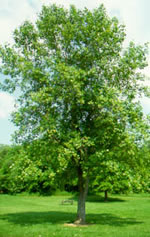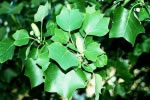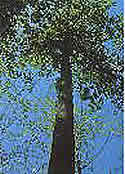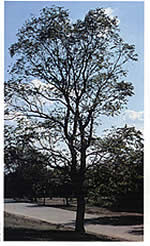|
Kentucky's State Tree
 About the Tulip Poplar About the Tulip Poplar
The controversy over Kentucky's state tree brewed for more than 40 years before being decided in 1994, with the selection of the Yellow Poplar, a.k.a. Tulip Tree or Tulip Poplar, or in botanical books Liriodendron tulipifera.
N ot an actual poplar, the Tulip Poplar is a member of the magnolia family. Its name is derived from the greenish-yellow tulip-like flowers the tree produces in the spring, usually in May. (Also, the leaves look like silhouettes of a tulip -- although most say that has nothing to do with its name.) The flowers' petals fall shortly after blooming, leaving behind cone-shaped clusters of winged seeds that ripen in the fall and drift away. The seeds are eaten by various t ot an actual poplar, the Tulip Poplar is a member of the magnolia family. Its name is derived from the greenish-yellow tulip-like flowers the tree produces in the spring, usually in May. (Also, the leaves look like silhouettes of a tulip -- although most say that has nothing to do with its name.) The flowers' petals fall shortly after blooming, leaving behind cone-shaped clusters of winged seeds that ripen in the fall and drift away. The seeds are eaten by various t ypes of birds and small animals, but aren't great favorites of any, except possibly cardinals. Once the seeds are blown away or devoured, the cones remain throughout the winter. ypes of birds and small animals, but aren't great favorites of any, except possibly cardinals. Once the seeds are blown away or devoured, the cones remain throughout the winter.
Tulip Poplars are rapid-growing and long-lived. They grow straight and are tall, averaging about 100 feet. The tallest living Tulip Poplar, according to the National Register of Big Trees, is located in Bedford, Virginia at 111 feet high, with a trunk over 31 feet around. The trunks of the Tulip Poplar are stout with gray furrowed bark. A Tulip Poplar's age can be estimated from the density, darkness of color, and amount of furrows in the bark. The oldest living Tulip Poplar, located in New York, is approximately 225 years old.
In Kentucky, the Tulip Poplar prefers the mountains of Eastern Kentucky. Tulip Poplars thrive in deep, moist soils along streams and in mountain coves. They need full sunlight to grow and develop; in dense woods, newly-germinated seedlings will survive only a few weeks. Instead, stands of Tulip Poplars are usually established in abandoned fields by wind-borne seeds.
About the Kentucky Coffee Tree
The only tree that has a commonly accepted name which includes a state name, the Kentucky Coffee Tree is the one of the only two remaining species  of Gymnocladus in existence. (The other is in China.) Gymnocladus means "naked branches," which the Coffee Tree has six months out of the year. of Gymnocladus in existence. (The other is in China.) Gymnocladus means "naked branches," which the Coffee Tree has six months out of the year.
The Coffee Tree is a legume, a flowering plant that produces compound leaves and pods containing seeds that are edible. (Although Coffee Tree beans are poisonous to humans unless roasted thoroughly.) The plant produces green-white unisexual flowers that attract insects to provide cross pollination. The seed pods are 6 to 10 inches long and usually appear in late summer and sometimes last throughout the winter. The beans are packed in a green gooey substance in the pods, and are also protected by a hard, dark green-brown shell. The seed pods are only produced by female plants.
The Kentucky Coffee Tree is a medium to large tree, usually reaching a height of 75 to 100 feet and a diameter of 2 1/2 feet. The largest Coffee Tree on record is located in Morgan County, Kentucky**, at a height of 78 feet tall and over 17 1/2 feet in diameter. The trunk of the Coffee Tree is short and divides into two to four secondary branches which are almost parallel to each other. The bark is dark gray and has rough projecting fissures. Young growth is stout often coated with a crusty film and fine hairs. The Kentucky Coffee Tree usually lives to be about 100 years old.
Found mostly in the midwest, the Kentucky Coffee Tree prefers deep, rich bottomland alluvial soils. The largest specimens can be found mostly in moist hollows on limestone soil, but the plant is tolerant of various soil types.
The Tulip Poplar vs. The Kentucky Coffee Tree
The first state tree, although unofficial, was the Tulip Poplar. In 1956, the tree was designated the official state tree during a session of the Kentucky Legislature. However, due to clerical oversight, the bill was not properly recorded in the state's statutes as passed legislation. Attempts to complete the formal adoption of the Tulip Poplar led to a declaration that it never was officiated as a state symbol. Even so, the error was not discovered until 1973, after references to Kentucky's state tree had been printed in countless reference books and encyclopedias across the nation and around the world.
In 1973, the General Assembly was asked to designate an "official" state tree. Joe Creason, a columnist for the Louisville Courier Journal, began a tongue-in-cheek campaign advocating the choice of the Kentucky Coffee Tree as one of the state's symbols. Creason's initial take at humor soon became the origin of a hot political debate, which many, including Creason, began to take seriously.
During the original 1956 debate, the Coffee Tree was a contender against the Tulip Poplar, as well as the Indian Cigar Tree and the popular Sycamore. Again a contender, the Kentucky Coffee Tree received wide support because it is the only tree with "Kentucky" in its English name. Leading the pro-Coffee Tree band of lobbyists was Dr. William C. Johnstone, a retired county agent from Berea. (Johnstone was known to carry Coffee Tree seeds in his pockets to distribute to anyone interested in the tree legislation.) Also in the Legislature were Coffee Tree supporters from Western Kentucky, Sen. Pat McCuiston (Democrat - Pembroke), Rep. James Bruce (Democrat - Hopkinsville) and Sen. Tom Garrett (Democrat - Paducah).
The deliberation was not without acrimony. Senators, once friends before the bill proposal, became antagonists. In newspapers and in front of television media, senators made derogatory quips at those even within their own political party. At the height of the controversy, some legislators were receiving more mail about the question of the state tree than other current events, such as Watergate, the stripmining battles in Eastern Kentucky, rising gas prices and inflation.
It was reported that in 1974 an unofficial consensus indeed had been made supporting the Tulip Poplar. However, Columnist Creason died before an official vote was made. Pressure from the media, wanting some sort of memorial to the revered newsman, only regenerated and exacerbated the tension and controversy surrounding the Coffee Tree bill. Members of the Legislature were again divided into the Poplars and the Coffee Trees. The Poplars even turned against the Governor. After the bill was revived when a vote of no support was made by the House of Representatives, Representative Dan Overstreet publicly stated that Governor Julian Carroll was using strong-arm tactics to support the coffee tree bill. He further proposed that the willow be a more appropriate state tree "because it bends with the prevailing breezes."* (Some thought that Carroll's support of the Coffee Tree bill was in the interest of supporting the memory of Creason rather than supporting the best choice for the state's tree.)
Also, rumors abounded that the legislation was really being passed to financially support nurseries that raised Coffee Trees. Sales of seedlings, plants, paintings, prints, wood carvings and gadgets related to the tree increased as the controversy escalated.
Historians were called in to prove the worth of the Coffee Tree to Kentucky history. It was found that early pioneers brewed a dark coffee-like drink by adding boiling water to the ground-up seeds from a tree found in Kentucky, thus the name "Kentucky Coffee Tree." In a letter to Thomas Jefferson, George Rogers Clark sent some of the seeds with the description, "It makes beautiful shade and I think it will flourish with you." (Kentucky Coffee Trees can be found at Jefferson's Monticello and at the University of Virginia, the school which he founded.) Among others who had Kentucky Coffee Trees on their estates were Cassius Marcellus Clay and General George Washington. Its wood was prized, being called "Kentucky Mahogany" for its rich color and dense grain. It was used for furniture and fence posts.
Further, Coffee Tree fanatic/advocate Johnstone pled with the General Assembly, claiming that the Kentucky Coffee Tree was close to being an endangered species. The seeds, said Johnstone, were very difficult to germinate. Once germinated, seedlings took three to four years to develop. Logging and commercial development hindered the establishment of the Coffee Tree in hardwood tree stands.
The debate, lasting two years, was temporarily resolved on February 16, 1976 when the Kentucky Coffee Tree became the first official state tree of Kentucky by S.B. 150. The act was celebrated on Arbor Day with the planting of a Kentucky Coffee Tree on the grounds of the Capitol by Governor Julian Carroll. The tree had been given to the Governor as a gift by Creason before his death.
But those in favor of the Tulip Poplar did not let this deter them from regaining the claim to official state tree status. In 1994, a movement was made to revive the state tree issue. Leading the pro-Poplars, was Majority Leader David Karem (Democrat - Louisville) and Dan Kelly (Republican - Springfield). Their argument for the poplar was based on the number of references to the Tulip Poplar already existing in print. The state would have to reimburse publishing companies for making the correction - a major expenditure for the Commonwealth. Advocates for the "Keep the Kentucky Coffee Tree" countered with the argument that the Tulip Poplar was already the state tree for neighbors Tennessee and Indiana, and Indiana already shared the cardinal with Kentucky as the state bird. Why share a tree, too?
Historians were again called in. Research began on the implications the tree had on the history of Kentucky. Because of their size, Tulip Poplars were hollowed out for canoes or dugouts. Originally, "canoe," meant a boat made by hollowing out a large light log. When Daniel Boone left Kentucky after his failed bartering attempt for land grants for his sponsor, the Transylvania Company, he packed his possessions and family into a 50 or 60 foot long tulip tree canoe and headed down the Ohio River. Settlers also used the vast trunks, at that time sometimes 10 feet in diameter, as hideouts from Indians. Also, the wood of the tulip tree was light and easily worked. Pioneers often used it for furniture and log cabins. In 1812, settlers making saltpeter for use in gunpowder used tulip tree pipes and troughs to carry nitrate-laden water to evaporating pans in Mammoth Cave. These can still be found there.
A bill to return the tulip poplar as Kentucky's official tree passed Kentucky's Senate on February 25, 1994 and was signed by the governor. (KRS 2.095) The fact that the Tulip Poplar is the fastest growing and most adaptive tree in the state's forests was cited as one reason for the change. State Senator Virgil Moore also commented that his forefathers crossed the Cumberland Gap and built their homes with poplars.
|
